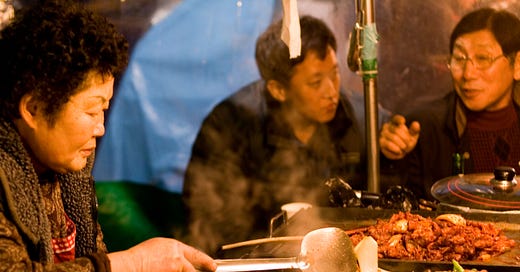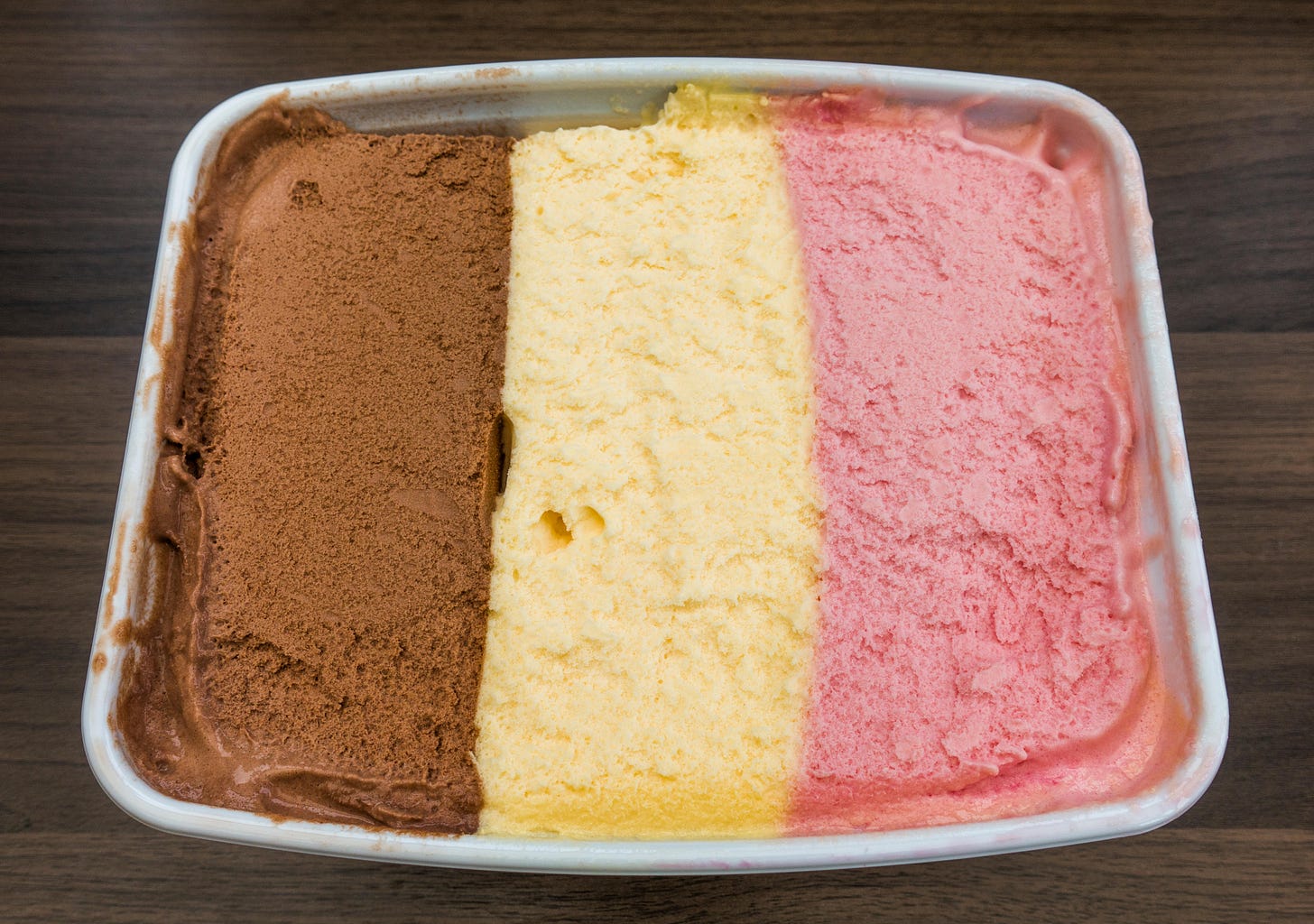If you enjoy the newsletter today, please forward it to someone who’d enjoy it, and tap the heart icon above, which will help me reach more readers. Thank you to everyone’s who’s been doing that, you’re absolute angels. Also consider signing up for a paid subscription. The money goes toward paying our contributors around the world. Substack sets the minimum at $5/month, so you can't give less than that,* but please feel absolutely free to give more. (You can choose any amount in the “supporter subscription plan” field.)
*If you would like to give less than $5, you can do that via Patreon, and it is very helpful and appreciated! You will also get podcast episodes one week early!
Christmas Cookies with Kim-Joy
You know how "Christmas is for kids"? That's actually a pretty recent idea. So are non-food presents! Great British Baking Show’s Kim-Joy has only one thing on her list: socks.
You can listen to Smart Mouth on iTunes, on RadioPublic, on Spotify - or any other podcast player!
Photo: Mathew Rice
Classic Ice Cream Flavor, New Cookie Creation
By Lia Picard
Maybe it’s because this pandemic has me feeling extra nostalgic, but when Neapolitan ice cream-flavored puff cereal caught my eye at Trader Joe’s, I was intrigued, and reminded of those rare days in elementary school when the teacher would throw an ice cream party. To please (almost) everyone she would buy a few tubs of that side-by-side-by-side combo: chocolate, vanilla, and strawberry.
After noticing those puffs at the store, I started to see Neapolitan ice cream-flavored treats everywhere. Annie’s Homegrown, the brand known for its “wholesome” takes on American childhood favorites, sells Neapolitan-flavored bunny graham crackers. These are actually the best — the strawberry tastes like strawberry! And this summer, cookbook author Sarah Kieffer’s Neapolitan cookies made the rounds on Instagram.
While Neapolitan ice cream is definitely having a moment in these new iterations, the flavor has been around for a long time. It was brought to America in the 1870s by Italian immigrants who created spumoni, molded ice cream made of three different flavors. Chocolate, vanilla, and strawberry became known as Neapolitan and stuck as the most popular variation: the New York Times referenced the flavor in an article written in 1887. Now it seems to be a flavor that everyone remembers — my mother-in-law enjoyed it as a child in the ‘60s — but never eats.
Photo: Shaun Daley / Alamy Stock Photo
Mathew Rice, a pastry chef based in Nashville, developed the Neapolitan cookie that inspired Sarah Kieffer. His cookie was first posted on Instagram in 2017 and has recently had a resurgence on the ‘gram. The cookies are multi-flavored swirly combination of three types of sugar cookie dough — he flavors the strawberry portion with Nesquik, which gives it an extra pop of pink. “When I was a kid, my grandmother consistently had Neapolitan ice cream at her house. It was the kind you got at the grocery store that used to be in a rectangle brick,” says Rice.
It’s unsurprising to Rice that culinarily, people are reaching back to their childhoods. “I’ve always worked with nostalgic ingredients. It’s my favorite thing to do because I feel like desserts should be comforting. Familiarity is nice, and it doesn't hurt when they're as pretty as the Neapolitan cookies.” 🍨
Photo: dbimages / Alamy Stock Photo
An American’s Guide to Anju, South Korea’s Drinking Fare
Back in the halcyon days of last December, the New York Times made its 2020 food and dining predictions, temporarily spiking the SEO value of one unfamiliar term: “makgeolli, the sparkling, fermented Korean rice liquor.” By February, South Korean director Bong Joon Ho’s “Parasite” swept the Oscars, taking home a Best Picture win. People googled what ram-don was. Beyond David Chang, Roy Choi, and crowd-pleasing bulgogi barbecue, Korean food seemed poised to gain further traction in the cultural mainstream.
Then, you-know-what happened.
Anju, Korean drinking fare meant to soak up alcoholic beverages like makgeolli and soju, had been teetering on the brink of popularity. Moving far beyond the realm of mixed nuts at sports bars, anju is similar to British pub food in heartiness and portion size. As restaurants and bars reopen for business across the country, anju’s major U.S. outposts are turning the lights back on, from Dan Sung Sa in L.A.’s Koreatown to Reception Bar on the Lower East Side in New York City. Anju’s window of opportunity for widespread adoption is opening back up, and you’d be remiss not to partake.
Photo: Yelp
In L.A., anju options are dizzying: the glistening clear potato noodles of a cold platter of japchae, kimchi fried rice with Spam, Korean fried chicken, fire-engine red ddeokbokki (spicy rice cakes), sizzling platters of corn cheese – the list goes on. A night of soju and conversation at a place like Dan Sung Sa or Toe Bang goes even later in front of a platter of haemul pajeon, a seafood-encrusted green onion pancake. Like doner kebabs after a night out in Berlin or a 3 a.m. slice of 24-hour pizza practically anywhere, anju isn’t exactly health food. But it’s heart food.
Elsewhere, Seattle’s aptly named Anju Bar and Eatery slings all of its greatest hits: japchae, kimchi rice, fried chicken, kimchi pajeon. Reflective of Japan’s colonial history on the Korean peninsula, Anju Bar’s menu also features katsu, teriyaki and curry.
Dan Sung Sa’s famous corn cheese. Photo: Yelp
With drinking so deeply embedded in Korean culture, it’s hard exactly to say where bar food ends and food-food begins. Washington D.C.’s Anju elevates an array of Korean classics, making the dishes less of an accompaniment, more of a whole damn meal. Chefs Danny Lee and Scott Drewno aren’t afraid to stay away from less flashy dishes either: their menu features samgyetang, a subtle ginseng-flavored chicken soup, and jjampong, a spicy broth heavy with fresh seafood and thick cut noodles.
For those understandably reluctant to embark on a night out, enough anju recipes and how-to guides exist online to recreate the experience at home. Darun Kwak’s corn cheese recipe from the Times Cooking section takes just fifteen minutes to make. Of course, there’s always Maangchi, and My Korean Kitchen’s carefully arranged recipe repository. In the end, makgeolli may not be the next mezcal, but anju’s mouthwatering array deserves a second look from any serious fan of mixing food and booze. 🍻
More Food Reading:
Edna Lewis only knew from fresh ingredients: her cooking was so simple because it could be, as she grew up eating everything straight from the farm. That’s why high-quality butter is an important part of her white pound cake, a classic Southern dish.
For Black people in Baltimore, Thanksgiving wouldn’t be Thanksgiving without sauerkraut.
This newsletter is edited by Katherine Spiers, host of the podcast Smart Mouth.
A TableCakes Production.
Want to contribute? Here are the submission guidelines.









